中考英语二轮语法专项复习 第04讲代词 课件
文档属性
| 名称 | 中考英语二轮语法专项复习 第04讲代词 课件 |  | |
| 格式 | pptx | ||
| 文件大小 | 1.4MB | ||
| 资源类型 | 试卷 | ||
| 版本资源 | 鲁教版 | ||
| 科目 | 英语 | ||
| 更新时间 | 2023-11-26 18:09:07 | ||
图片预览




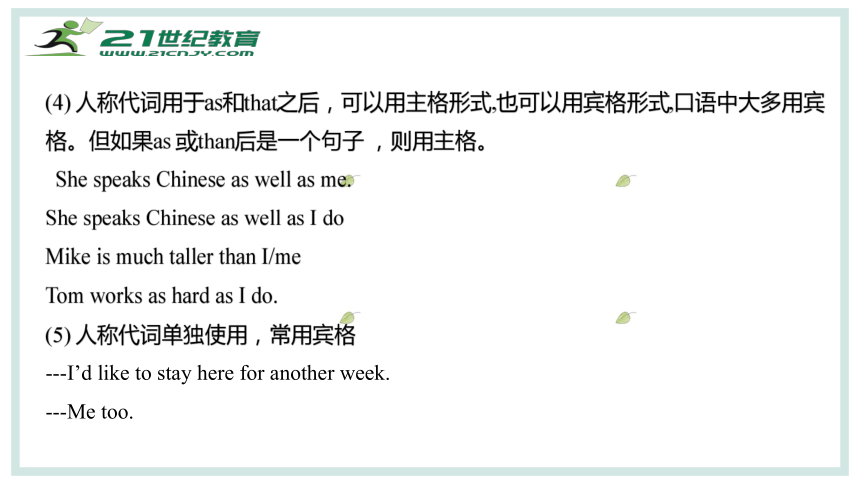
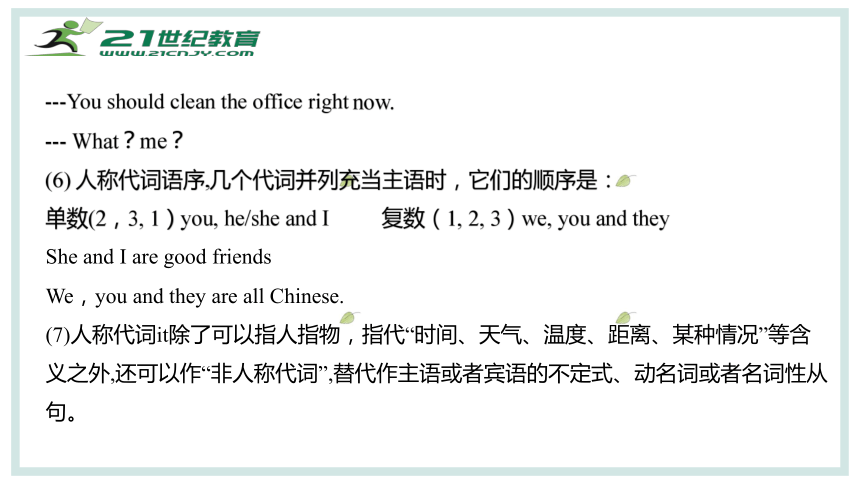


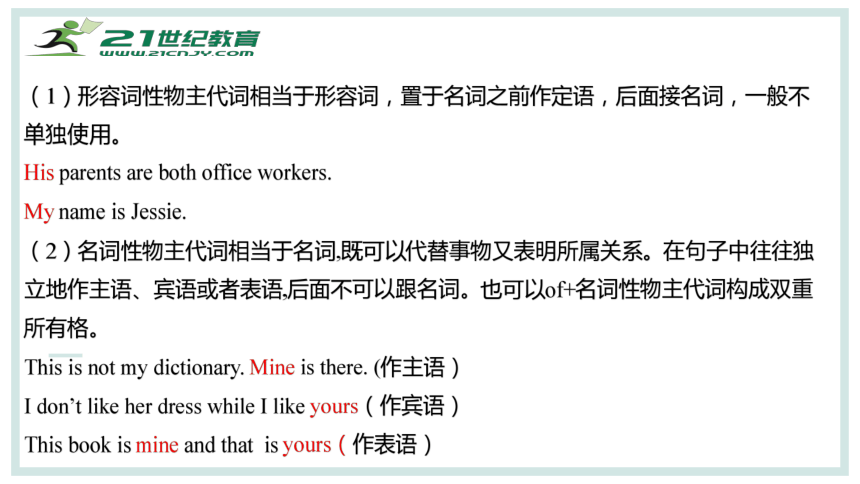
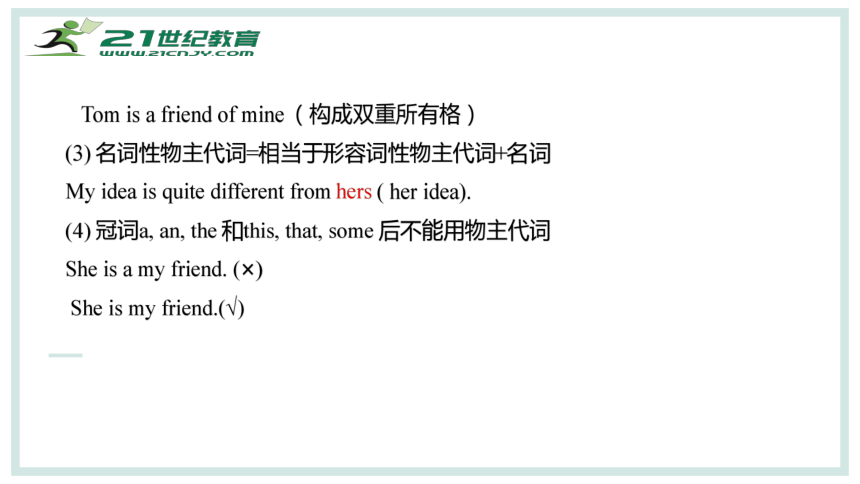
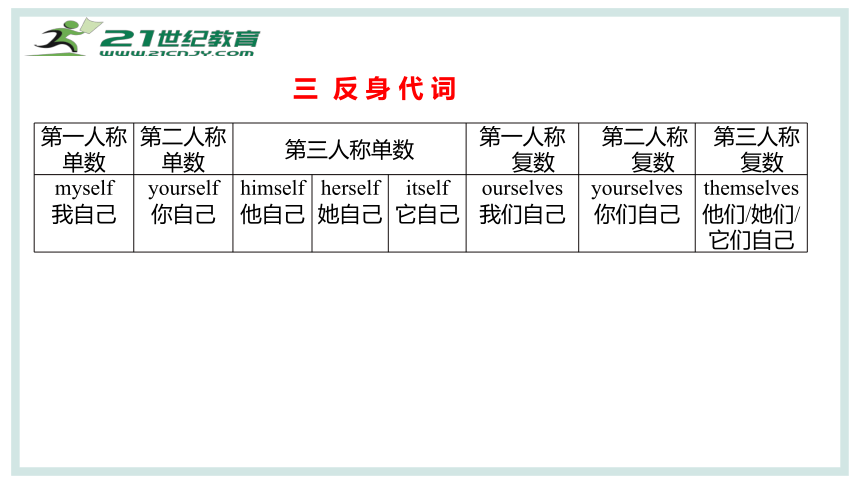
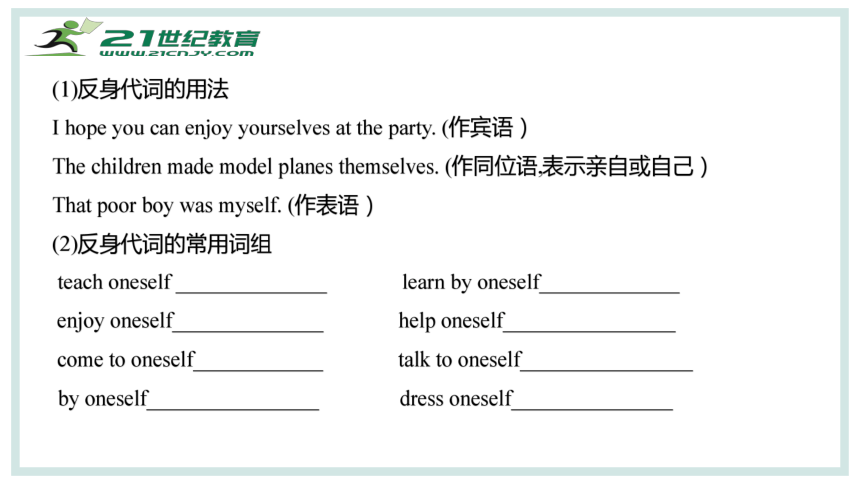
文档简介
(共46张PPT)
第四讲 代 词
中考英语专项复习
1.能够熟练掌握代词的分类及使用。
2.熟悉中考代词考点并灵活应用代词。
学习目标
一 人 称 代 词
人称代词 单 数 复 数 第一人称 第二人称 第三人称 第一人称 第二人称 第三人称
他 她 它
主 格
宾 格
I
me
you
you
he
him
she
her
it
it
we
us
you
you
they
them
(1) 人称代词的主格在句中充当主语
She is a good student.
(2) 人称代词宾格在句中充当动词、介词的宾语
I don’t know her.
His mother is waiting for him outside.
(3)作表语, 作表语一般用主格,但在口语中常用宾格
I saw it at once it was her. 我马上看出是她
—Who is there —It’s I/me.
(4) 人称代词用于as和that之后,可以用主格形式,也可以用宾格形式,口语中大多用宾格。但如果as 或than后是一个句子 ,则用主格。
She speaks Chinese as well as me.
She speaks Chinese as well as I do
Mike is much taller than I/me
Tom works as hard as I do.
(5) 人称代词单独使用,常用宾格
---I’d like to stay here for another week.
---Me too.
---You should clean the office right now.
--- What?me?
(6) 人称代词语序,几个代词并列充当主语时,它们的顺序是:
单数(2,3, 1)you, he/she and I 复数(1, 2, 3)we, you and they
She and I are good friends
We,you and they are all Chinese.
(7)人称代词it除了可以指人指物,指代“时间、天气、温度、距离、某种情况”等含义之外,还可以作“非人称代词”,替代作主语或者宾语的不定式、动名词或者名词性从句。
It took him three hours to finish his homework.(作形式主语)
I found it very difficult to learn a foreign language well.(作形式宾语)
It is a great pity that they didn't get married.(名词性从句)
二 物 主 代 词
物主代词分为形容性物主代词和名词性物主代词
物主 代词 单数 复数 第一人称 第二人称 第三人称 第一人称 第二人称 第三人称
我的 你的 他的 她的 它的 我们的 你们的 他/她/它们的
形容词性物主代词
名词词性物主代词
my
mine
your
yours
his
his
her
hers
its
its
ours
our
your
yours
their
theirs
文本信息
标题数字等都可以通过点击和重新输入进行更改。文字数字大小颜色参考此模板
(1)形容词性物主代词相当于形容词,置于名词之前作定语,后面接名词,一般不单独使用。
His parents are both office workers.
My name is Jessie.
(2)名词性物主代词相当于名词,既可以代替事物又表明所属关系。在句子中往往独立地作主语、宾语或者表语,后面不可以跟名词。也可以of+名词性物主代词构成双重所有格。
This is not my dictionary. Mine is there. (作主语)
I don’t like her dress while I like yours(作宾语)
This book is mine and that is yours(作表语)
文本信息
标题数字等都可以通过点击和重新输入进行更改。文字数字大小颜色参考此模板
Tom is a friend of mine (构成双重所有格)
(3) 名词性物主代词=相当于形容词性物主代词+名词
My idea is quite different from hers ( her idea).
(4) 冠词a, an, the 和this, that, some 后不能用物主代词
She is a my friend. (×)
She is my friend.(√)
三 反 身 代 词
第一人称 单数 第二人称 单数 第三人称单数 第一人称 复数 第二人称 复数 第三人称
复数
myself 我自己 yourself你自己 himself他自己 herself她自己 itself 它自己 ourselves 我们自己 yourselves 你们自己 themselves
他们/她们/它们自己
(1)反身代词的用法
I hope you can enjoy yourselves at the party. (作宾语)
The children made model planes themselves. (作同位语,表示亲自或自己)
That poor boy was myself. (作表语)
(2)反身代词的常用词组
teach oneself ______________ learn by oneself_____________
enjoy oneself______________ help oneself________________
come to oneself____________ talk to oneself________________
by oneself________________ dress oneself_______________
四 指 示 代 词
单数 this 这个
that 那个
复数 these 这些
those 那些
(1) this/these
① 表示时间或空间上较近的人或物 This is my pen. These are my books.
② 指下文要提到的事 Please remember this: No pains, no gains.
(2) that/those
① 表示时间或空间上较远的人或物 That’s her bike.
② 指前面刚刚提到过的事
He was ill. That was why he didn’t go to school.
③ 打电话用this介绍自己,that 表示对方
This is Jessie speaking. Is that Jack speaking
输入文本信息
标题数字等都可以通过点击和重新输入进行更改。文字数字大小颜色参考此模板
输入文本信息
标题数字等都可以通过点击和重新输入进行更改。文字数字大小颜色参考此模板
五 疑 问 代 词
疑问代词 主要用法 例句
who 谁;问人(主格) Who wants to go with me
whom 谁;问人(宾格) To whom are you talking
whose 谁的,所属关系 Whose book is this
what 什么 What’s your father —He is a doctor.
which 哪一个;哪一些 Which one do you like best
用来构成特殊疑问句的代词叫疑问代词。
六 it 的 用法
1. it 可用作人称代词,在句中可以做主语,也可做宾语等。可以指人,物或事。
⑴ it 指人时表示说话者心中不太确定的那个人,常在打电话或敲门时用。如:
---Who is that speaking
--- It is me.
⑵ it 指事物时,可指代有生命的(包括动物),也可指无生命的。注意 it指物时,表示同类同物。如:
This is my cat. It is very lazy.
输入标题文本信息
标题数字等都可以通过点击和重新输入进行更改。文字数字大小颜色参考此模板
2. it 可以指代时间,天气,距离,气候,季节,长度,重量等。
-- What time is it ---- It is 12:20.
--What’s the weather like today ---- It is sunny.
It is 112 miles from London to Birmingham.
3. 作形式主语,替代动词不定式或动名词
动词不定式或动名词作主语时,为了避免主语太长,头重脚轻,可以用it 代替动词不定式/动名词作形式主语,真正的主语不定式/动名词放到句后。如:
To learn Chinese well is not easy. 可改写成:
It is not easy To learn Chinese well
输入文本信息
点击此处输入文本信息。标题数字等都可以通过点击和重新输入进行更改,菜单设置中功能区可以对字体、字号、颜色、行距等进行修改。文字数字大小颜色参考此模板
4. it 做形式宾语,在一部分动词后可以代替动词不定式/动名词做宾语,同时后面要跟有宾语补足语。如 find, think, believe, make, feel等。
常构成“主语+v.+it+宾补(adj./n)+不定式/动名词”结构。如:
He thinks it easy to finish the task.
Mike found it difficult to learn math.
T文本信息
点击此处输入文本信息。标题数字等都可以通过点击和重新输入进行更改,菜单设置中功能区可以对字体、字号、颜色、行距等进行修改。文字数字大小颜色参考此模板
5 it one that 作替代物的区别
it 同类同物, one 同类不同物, that 避免重复
The book is Tom’s, and it is very interesting.
---Who has a pen? ---I have one
The weather in Beijing is colder than that in Guangzhou in Winter.
(1) some/any的用法
相同点:some/any均表示“一些”,既可以修饰可数名词,也可以修饰不可数名词。
不同点:some一般用于肯定句,any用疑问句,否定句和条件句。
但在疑问句中当表示说话人希望得到肯定回答或表达请求、建议时用some。
There aren’t any students in the classroom.
Look! Some boys are playing football.
Would you like some tea
七 不 定 代 词
替代或修饰不特指的人或事物的代词叫不定代词。
(2) many和much的用法:
many“很多”, 后接可数名词复数;much“很多”, 后接不可数名词。 ,表示太多的时候可在前面加too。可在句中可作主语、宾语和定语等。
Many students have tried,but few have succeeded.
many. much除直接后面加名词外,后还可跟of...,但此时后面的名词或代词有范围,是特指。
Many students like playing computer games 这里的很多学生无范围限制,可理解为大多数学生这样
Many of students in our class like playing computer games .限定了本班这个范围。
点击此处
输入文本信息
( 3 ) each和every的用法
each其后可以+of every其后不可以+of
可单独使用 不可单独使用
可作代词、形容词 仅作形容词
着重“个别” 着重“全体”,毫无例外
用于两者或两者以上中的每一个人或物 用于三者或三者以上中的每一个人或物
Every student in Class 5 passed the exam.
Each of us wears a yellow shirt.
We each wear a yellow shirt.
(4 ) a few/ few/ a little/ little的用法
few、little意思是“很少几个”、“几乎没有”,有否定的意思,
a few、a little意思是“有几个”、“有些”, 有肯定的意思 ;
few、a few与可数名词连用或代替可数的事物,
little、a little与不可数名词连用或代替不可数的事物。
在句中可作主语、宾语和定语。
用法 修饰复数名词 修饰不可数名词
含肯定的意思 a few a little
含否定的意思 few little
例句
1—Would you please buy some salt for me —There is little left.
2. Take it easy. There is still a little time left.
3.Few people live there.(在那个地区几乎不住人)
4.You can get a few candies from him.(你能从他那儿获得一些糖)
【注意】a little与a bit的用法区分
两者都可单独使用或表程度(作状语,有点儿,稍微)
The professer talked a little/a bit about his research
The box is a little/a bit heavy
不同之处在于,a little后面直接加不可数名词,而a bit后面先加of 再加不可数名词
not a little 很多,很 not a bit 一点也没有 一点也不
There is a little/a bit of room left for the furniture.(此处room为空间,不可数名词)
点击此处
输入文本信息
(5 ) no和none的用法:
no 形容词,作定语,意思是“没有”,修饰可数名词(单数或复数)或不可数名词。
none在句子中可作主语、宾语和表语,意思是“没有一个人(或事物)”,表示复数或单数,可组成none of...。
1.There is no money left.
2.They had no books to read.
3.I have many books, but none is interesting.
4.None of them is/are in the classroom.(他们当中没有一个在教室里
点击此处
输入文本信息
(6) all和both的用法:
all指三者或三者以上的人或物,代替或修饰可数名词,也可代替或修饰不可数名词。
both指两个人或物,用来代替或修饰可数名词,可组成both...and...
all和both在句子中都作主语、宾语、表语、定语等。
all和both既可以修饰名词(all/both+(the)+名词),也可用“all/both + of the +名词(复数)”的形式,有时of 可以省略。
1.I know all of the five Chinese students in their school.
2.—Would you like this pen or that one — Both (两个都要)
3. Both (of) (the) boys are smart.
点击此处
输入文本信息
(7 ) either和neither的用法:
either 意思是“两个中间的任何一个”, 可组成either of
neither 意思是“两个都不”,可组成neither of
neither和either在句子中可作主语、宾语和定语等,都用作单数。
1.I don’t care much for what to drink. Either of the two will be OK.
2.---Will you go there by ship or by car
-- Neither. I will go there by air.(——你坐船去还是坐车去?——都不是,我乘飞机去。)
点击此处
输入文本信息
① both...and...两者都 Both his father and his mother are teacher.
② neither...nor...两者都不 Neither his father nor his mother is teacher.
either...or..或...或...;要么...要么... Either he or his brother goes to London.
③ either/neither of + 名词(代词)的复数 + 谓语动词(第三人称单数)
Neither of the books is good.
④ either...or.../neither...nor...连接两个主语时,采取就近原则
Neither you nor he is wrong.
常 考 短 语
点击此处
输入文本信息
(8) one与ones的区分
one用来代替可数名词单数,既可指人也可指物。其复数形式为ones,所有格形式为one’s,反身代词为oneself。
①单独用,泛指人或人们
One often fails to see his own fault 一个人往往看不见自己的缺点
②指代同名异物的可数名词,单数用one 复数用ones
Which dress would you like, this one or that one
点击此处
输入文本信息
(9) so such the same的用法
so的用法:
①用在believe,think,expect,imagine,guess等词后面用so代替前面提出的观点,既可用于肯定句也可用于否定句。
I think so/ I don't think so
②用在hope,suppose, I am afraid 后面,代替前面提出的观点,此时只能用于肯定句
---The cold weather might continue for days
---I hope so/I hope not
③so可以代替一件事情
He lost a book. So did I.(他丢失了一本书,我也是。)
点击此处
输入文本信息
such 的用法
such作代词可单独使用,指上下文所述的这样的人或事物,在句中作主语,宾语,表语,还可用作限定语,修饰名词,有时such后可加as用来引出属于哪一类,
We come aross such a terrible day that we couldn’t move on.
There is no such thing as a free lunch 天下没有免费的午餐
the same的用法
①单独使用the same,指刚提到的同一个人或事物
Whatever I do,he tries to do the same
--Happy new year
--The same to you
点击此处
输入文本信息
② the same修饰后面的名词
You alwasys repeat the same old story
③the same用在动词后面,
I feel the same as yesterday
可组成the same...as 短语as后面可跟代词,名词或句子
I am the same age as you
点击此处
输入文本信息
(10)a lot of、lots of、a number of( /large numbers of)、a great deal of、plenty of的区别
①都是“名词+介词”的短语,意思都都表示“大量,许多”
②a lot of(或lots of)后加不可数名词也可以加可数名词的复数形式,可以相应地换为much和many;
③plenty of“足够、大量”,既可以修饰不可数名词也可以修饰可数名词的复数形式。
④a number of / large numbers of 只能修饰可数名词复数形式并且它修饰的词作主语时谓语用复数形式,可以替换为some、many、a lot of、plenty of。
⑤a great deal ofv只能修饰不可数名词,它修饰的词作主语时谓语用单数形式,可以换为much。
点击此处
输入文本信息
(11) other/the other/others/the others/another的用法
不定代词 意义 用法说明
other 另外的 只作定语
the other 两者中的另一个 常用于one... the other...句型
others 泛指别的人或物 常用于some...others...句型
the others 特指其余所有的人或物 剩余的全部
another 任何一个,另一个 三者或三者以上的任何一个
点击此处
输入文本信息
1.Some girls are dancing under the tree and others are sitting on the grass .
2.You have had several apples. Do you really want another one
3.This is one of your socks. Where is he other one
4.A few students are playing soccer while others are watching them.)
5.Two of the ten boys are standing and the others are sitting round them.
(12) 复合不定代词
单词 body one thing
some
any
no
every
注:复合不定代词有12个:something(某事), someone(某人), somebody(某人), anything(任何事), anyone(任何人), anybody(任何人), nothing(没事),nobody(没有人), no one(没有人), everything(一切), everyone(每个人), everybody(每个人)。
复合不定代词的用法
(1)含-body和-one的复合代词只用来指人,含-body的复合不定代词与含-one的复合不定代词在功能和意义上完全相同,可以互换;含-thing的复合不定代词只用来指事物
(2)复合不定代词都具有单数的含义,因此通常被看成是单数第三人称。当它们充当句子的主语时,其后的谓语动词用单数形式。
Is everyone here today 今天,大家都到齐了吗?
Nothing is difficult if you put your heart into it.世上无难事,只怕有心人。
(3)含-one和-body等指人的复合代词可有-’s所有格形式。含-thing等指事物的复合不定代词没有-‘s所有格形式。如:
Is this anybody’s seat 这儿有人坐吗?
当其后有else时,-’s要加在else后面。
That must be somebody else‘s coat; it isn’t mine. 那一定是别人的外衣,不是我的。
(4)当要对一群人讲话时,可使用以复合不定代词作主语的祈使句,句中的动词用原形。如:
Nobody move!= Don’t anybody move! 都别动!
Everyone lie down! 统统趴下!
(5)、something,someone,somebody通常用于肯定句中,而anything,anyone,anybody一般用于否定句,疑问句或条件状语从句中。如:
He found something strange but interesting.他发现了一些奇怪但却有趣的事情。
Do you have anything to say ?你有话要说吗?
(6)在表示请求、邀请、提建议等带有委婉语气的疑问句,和希望得到对方肯定答复的疑问句,以及表示反问的问句中,也用something,someone,somebody等复合不定代词。如:
Would you like something to eat 要些吃的东西吗?
Isn’t there something wrong with you 难道你没问题吗?
(7) 当anything表示“任何事(物),无论何事(物)”,anyone,anybody表示“无论谁,任何人”等意义时,它们也可以用于肯定句中。如:
Anything is OK. 什么都行。
Anybody knows the answer.任何人都知道答案。
1 ---It is said that Tina will go to Canada by herself.
--Yes, ___ of her parents will go with her
A both B neither C either D none
2 (2023·雅安·中考真题)
—Mr. Brown, I find ______ hard to learn English well.
—Come on! Practice makes perfect.
A.that B.it C.this D.its
B
B
3.(2023·黑龙江齐齐哈尔·统考中考真题)Teachers often say that teenagers should learn to look after ________.
A.ourselves B.yourselves C.themselves
4.(2023·山东菏泽·统考中考真题)
—Hurry up! The bus is leaving soon.
—Don’t worry. There is ________ time left.
A.no B.little C.a little
C
C
5 --- I am a little hungry,Mom
---There are some apple pies on the table.You can take ______
A it B that C one
6.(2023·营口·中考真题)Daming is happy today because he helped ________ look for a set of keys on his way home.
A.nobody B.anybody C.somebody D.everybody
C
C
谢谢
21世纪教育网(www.21cnjy.com)
中小学教育资源网站
兼职招聘:
https://www.21cnjy.com/recruitment/home/admin
第四讲 代 词
中考英语专项复习
1.能够熟练掌握代词的分类及使用。
2.熟悉中考代词考点并灵活应用代词。
学习目标
一 人 称 代 词
人称代词 单 数 复 数 第一人称 第二人称 第三人称 第一人称 第二人称 第三人称
他 她 它
主 格
宾 格
I
me
you
you
he
him
she
her
it
it
we
us
you
you
they
them
(1) 人称代词的主格在句中充当主语
She is a good student.
(2) 人称代词宾格在句中充当动词、介词的宾语
I don’t know her.
His mother is waiting for him outside.
(3)作表语, 作表语一般用主格,但在口语中常用宾格
I saw it at once it was her. 我马上看出是她
—Who is there —It’s I/me.
(4) 人称代词用于as和that之后,可以用主格形式,也可以用宾格形式,口语中大多用宾格。但如果as 或than后是一个句子 ,则用主格。
She speaks Chinese as well as me.
She speaks Chinese as well as I do
Mike is much taller than I/me
Tom works as hard as I do.
(5) 人称代词单独使用,常用宾格
---I’d like to stay here for another week.
---Me too.
---You should clean the office right now.
--- What?me?
(6) 人称代词语序,几个代词并列充当主语时,它们的顺序是:
单数(2,3, 1)you, he/she and I 复数(1, 2, 3)we, you and they
She and I are good friends
We,you and they are all Chinese.
(7)人称代词it除了可以指人指物,指代“时间、天气、温度、距离、某种情况”等含义之外,还可以作“非人称代词”,替代作主语或者宾语的不定式、动名词或者名词性从句。
It took him three hours to finish his homework.(作形式主语)
I found it very difficult to learn a foreign language well.(作形式宾语)
It is a great pity that they didn't get married.(名词性从句)
二 物 主 代 词
物主代词分为形容性物主代词和名词性物主代词
物主 代词 单数 复数 第一人称 第二人称 第三人称 第一人称 第二人称 第三人称
我的 你的 他的 她的 它的 我们的 你们的 他/她/它们的
形容词性物主代词
名词词性物主代词
my
mine
your
yours
his
his
her
hers
its
its
ours
our
your
yours
their
theirs
文本信息
标题数字等都可以通过点击和重新输入进行更改。文字数字大小颜色参考此模板
(1)形容词性物主代词相当于形容词,置于名词之前作定语,后面接名词,一般不单独使用。
His parents are both office workers.
My name is Jessie.
(2)名词性物主代词相当于名词,既可以代替事物又表明所属关系。在句子中往往独立地作主语、宾语或者表语,后面不可以跟名词。也可以of+名词性物主代词构成双重所有格。
This is not my dictionary. Mine is there. (作主语)
I don’t like her dress while I like yours(作宾语)
This book is mine and that is yours(作表语)
文本信息
标题数字等都可以通过点击和重新输入进行更改。文字数字大小颜色参考此模板
Tom is a friend of mine (构成双重所有格)
(3) 名词性物主代词=相当于形容词性物主代词+名词
My idea is quite different from hers ( her idea).
(4) 冠词a, an, the 和this, that, some 后不能用物主代词
She is a my friend. (×)
She is my friend.(√)
三 反 身 代 词
第一人称 单数 第二人称 单数 第三人称单数 第一人称 复数 第二人称 复数 第三人称
复数
myself 我自己 yourself你自己 himself他自己 herself她自己 itself 它自己 ourselves 我们自己 yourselves 你们自己 themselves
他们/她们/它们自己
(1)反身代词的用法
I hope you can enjoy yourselves at the party. (作宾语)
The children made model planes themselves. (作同位语,表示亲自或自己)
That poor boy was myself. (作表语)
(2)反身代词的常用词组
teach oneself ______________ learn by oneself_____________
enjoy oneself______________ help oneself________________
come to oneself____________ talk to oneself________________
by oneself________________ dress oneself_______________
四 指 示 代 词
单数 this 这个
that 那个
复数 these 这些
those 那些
(1) this/these
① 表示时间或空间上较近的人或物 This is my pen. These are my books.
② 指下文要提到的事 Please remember this: No pains, no gains.
(2) that/those
① 表示时间或空间上较远的人或物 That’s her bike.
② 指前面刚刚提到过的事
He was ill. That was why he didn’t go to school.
③ 打电话用this介绍自己,that 表示对方
This is Jessie speaking. Is that Jack speaking
输入文本信息
标题数字等都可以通过点击和重新输入进行更改。文字数字大小颜色参考此模板
输入文本信息
标题数字等都可以通过点击和重新输入进行更改。文字数字大小颜色参考此模板
五 疑 问 代 词
疑问代词 主要用法 例句
who 谁;问人(主格) Who wants to go with me
whom 谁;问人(宾格) To whom are you talking
whose 谁的,所属关系 Whose book is this
what 什么 What’s your father —He is a doctor.
which 哪一个;哪一些 Which one do you like best
用来构成特殊疑问句的代词叫疑问代词。
六 it 的 用法
1. it 可用作人称代词,在句中可以做主语,也可做宾语等。可以指人,物或事。
⑴ it 指人时表示说话者心中不太确定的那个人,常在打电话或敲门时用。如:
---Who is that speaking
--- It is me.
⑵ it 指事物时,可指代有生命的(包括动物),也可指无生命的。注意 it指物时,表示同类同物。如:
This is my cat. It is very lazy.
输入标题文本信息
标题数字等都可以通过点击和重新输入进行更改。文字数字大小颜色参考此模板
2. it 可以指代时间,天气,距离,气候,季节,长度,重量等。
-- What time is it ---- It is 12:20.
--What’s the weather like today ---- It is sunny.
It is 112 miles from London to Birmingham.
3. 作形式主语,替代动词不定式或动名词
动词不定式或动名词作主语时,为了避免主语太长,头重脚轻,可以用it 代替动词不定式/动名词作形式主语,真正的主语不定式/动名词放到句后。如:
To learn Chinese well is not easy. 可改写成:
It is not easy To learn Chinese well
输入文本信息
点击此处输入文本信息。标题数字等都可以通过点击和重新输入进行更改,菜单设置中功能区可以对字体、字号、颜色、行距等进行修改。文字数字大小颜色参考此模板
4. it 做形式宾语,在一部分动词后可以代替动词不定式/动名词做宾语,同时后面要跟有宾语补足语。如 find, think, believe, make, feel等。
常构成“主语+v.+it+宾补(adj./n)+不定式/动名词”结构。如:
He thinks it easy to finish the task.
Mike found it difficult to learn math.
T文本信息
点击此处输入文本信息。标题数字等都可以通过点击和重新输入进行更改,菜单设置中功能区可以对字体、字号、颜色、行距等进行修改。文字数字大小颜色参考此模板
5 it one that 作替代物的区别
it 同类同物, one 同类不同物, that 避免重复
The book is Tom’s, and it is very interesting.
---Who has a pen? ---I have one
The weather in Beijing is colder than that in Guangzhou in Winter.
(1) some/any的用法
相同点:some/any均表示“一些”,既可以修饰可数名词,也可以修饰不可数名词。
不同点:some一般用于肯定句,any用疑问句,否定句和条件句。
但在疑问句中当表示说话人希望得到肯定回答或表达请求、建议时用some。
There aren’t any students in the classroom.
Look! Some boys are playing football.
Would you like some tea
七 不 定 代 词
替代或修饰不特指的人或事物的代词叫不定代词。
(2) many和much的用法:
many“很多”, 后接可数名词复数;much“很多”, 后接不可数名词。 ,表示太多的时候可在前面加too。可在句中可作主语、宾语和定语等。
Many students have tried,but few have succeeded.
many. much除直接后面加名词外,后还可跟of...,但此时后面的名词或代词有范围,是特指。
Many students like playing computer games 这里的很多学生无范围限制,可理解为大多数学生这样
Many of students in our class like playing computer games .限定了本班这个范围。
点击此处
输入文本信息
( 3 ) each和every的用法
each其后可以+of every其后不可以+of
可单独使用 不可单独使用
可作代词、形容词 仅作形容词
着重“个别” 着重“全体”,毫无例外
用于两者或两者以上中的每一个人或物 用于三者或三者以上中的每一个人或物
Every student in Class 5 passed the exam.
Each of us wears a yellow shirt.
We each wear a yellow shirt.
(4 ) a few/ few/ a little/ little的用法
few、little意思是“很少几个”、“几乎没有”,有否定的意思,
a few、a little意思是“有几个”、“有些”, 有肯定的意思 ;
few、a few与可数名词连用或代替可数的事物,
little、a little与不可数名词连用或代替不可数的事物。
在句中可作主语、宾语和定语。
用法 修饰复数名词 修饰不可数名词
含肯定的意思 a few a little
含否定的意思 few little
例句
1—Would you please buy some salt for me —There is little left.
2. Take it easy. There is still a little time left.
3.Few people live there.(在那个地区几乎不住人)
4.You can get a few candies from him.(你能从他那儿获得一些糖)
【注意】a little与a bit的用法区分
两者都可单独使用或表程度(作状语,有点儿,稍微)
The professer talked a little/a bit about his research
The box is a little/a bit heavy
不同之处在于,a little后面直接加不可数名词,而a bit后面先加of 再加不可数名词
not a little 很多,很 not a bit 一点也没有 一点也不
There is a little/a bit of room left for the furniture.(此处room为空间,不可数名词)
点击此处
输入文本信息
(5 ) no和none的用法:
no 形容词,作定语,意思是“没有”,修饰可数名词(单数或复数)或不可数名词。
none在句子中可作主语、宾语和表语,意思是“没有一个人(或事物)”,表示复数或单数,可组成none of...。
1.There is no money left.
2.They had no books to read.
3.I have many books, but none is interesting.
4.None of them is/are in the classroom.(他们当中没有一个在教室里
点击此处
输入文本信息
(6) all和both的用法:
all指三者或三者以上的人或物,代替或修饰可数名词,也可代替或修饰不可数名词。
both指两个人或物,用来代替或修饰可数名词,可组成both...and...
all和both在句子中都作主语、宾语、表语、定语等。
all和both既可以修饰名词(all/both+(the)+名词),也可用“all/both + of the +名词(复数)”的形式,有时of 可以省略。
1.I know all of the five Chinese students in their school.
2.—Would you like this pen or that one — Both (两个都要)
3. Both (of) (the) boys are smart.
点击此处
输入文本信息
(7 ) either和neither的用法:
either 意思是“两个中间的任何一个”, 可组成either of
neither 意思是“两个都不”,可组成neither of
neither和either在句子中可作主语、宾语和定语等,都用作单数。
1.I don’t care much for what to drink. Either of the two will be OK.
2.---Will you go there by ship or by car
-- Neither. I will go there by air.(——你坐船去还是坐车去?——都不是,我乘飞机去。)
点击此处
输入文本信息
① both...and...两者都 Both his father and his mother are teacher.
② neither...nor...两者都不 Neither his father nor his mother is teacher.
either...or..或...或...;要么...要么... Either he or his brother goes to London.
③ either/neither of + 名词(代词)的复数 + 谓语动词(第三人称单数)
Neither of the books is good.
④ either...or.../neither...nor...连接两个主语时,采取就近原则
Neither you nor he is wrong.
常 考 短 语
点击此处
输入文本信息
(8) one与ones的区分
one用来代替可数名词单数,既可指人也可指物。其复数形式为ones,所有格形式为one’s,反身代词为oneself。
①单独用,泛指人或人们
One often fails to see his own fault 一个人往往看不见自己的缺点
②指代同名异物的可数名词,单数用one 复数用ones
Which dress would you like, this one or that one
点击此处
输入文本信息
(9) so such the same的用法
so的用法:
①用在believe,think,expect,imagine,guess等词后面用so代替前面提出的观点,既可用于肯定句也可用于否定句。
I think so/ I don't think so
②用在hope,suppose, I am afraid 后面,代替前面提出的观点,此时只能用于肯定句
---The cold weather might continue for days
---I hope so/I hope not
③so可以代替一件事情
He lost a book. So did I.(他丢失了一本书,我也是。)
点击此处
输入文本信息
such 的用法
such作代词可单独使用,指上下文所述的这样的人或事物,在句中作主语,宾语,表语,还可用作限定语,修饰名词,有时such后可加as用来引出属于哪一类,
We come aross such a terrible day that we couldn’t move on.
There is no such thing as a free lunch 天下没有免费的午餐
the same的用法
①单独使用the same,指刚提到的同一个人或事物
Whatever I do,he tries to do the same
--Happy new year
--The same to you
点击此处
输入文本信息
② the same修饰后面的名词
You alwasys repeat the same old story
③the same用在动词后面,
I feel the same as yesterday
可组成the same...as 短语as后面可跟代词,名词或句子
I am the same age as you
点击此处
输入文本信息
(10)a lot of、lots of、a number of( /large numbers of)、a great deal of、plenty of的区别
①都是“名词+介词”的短语,意思都都表示“大量,许多”
②a lot of(或lots of)后加不可数名词也可以加可数名词的复数形式,可以相应地换为much和many;
③plenty of“足够、大量”,既可以修饰不可数名词也可以修饰可数名词的复数形式。
④a number of / large numbers of 只能修饰可数名词复数形式并且它修饰的词作主语时谓语用复数形式,可以替换为some、many、a lot of、plenty of。
⑤a great deal ofv只能修饰不可数名词,它修饰的词作主语时谓语用单数形式,可以换为much。
点击此处
输入文本信息
(11) other/the other/others/the others/another的用法
不定代词 意义 用法说明
other 另外的 只作定语
the other 两者中的另一个 常用于one... the other...句型
others 泛指别的人或物 常用于some...others...句型
the others 特指其余所有的人或物 剩余的全部
another 任何一个,另一个 三者或三者以上的任何一个
点击此处
输入文本信息
1.Some girls are dancing under the tree and others are sitting on the grass .
2.You have had several apples. Do you really want another one
3.This is one of your socks. Where is he other one
4.A few students are playing soccer while others are watching them.)
5.Two of the ten boys are standing and the others are sitting round them.
(12) 复合不定代词
单词 body one thing
some
any
no
every
注:复合不定代词有12个:something(某事), someone(某人), somebody(某人), anything(任何事), anyone(任何人), anybody(任何人), nothing(没事),nobody(没有人), no one(没有人), everything(一切), everyone(每个人), everybody(每个人)。
复合不定代词的用法
(1)含-body和-one的复合代词只用来指人,含-body的复合不定代词与含-one的复合不定代词在功能和意义上完全相同,可以互换;含-thing的复合不定代词只用来指事物
(2)复合不定代词都具有单数的含义,因此通常被看成是单数第三人称。当它们充当句子的主语时,其后的谓语动词用单数形式。
Is everyone here today 今天,大家都到齐了吗?
Nothing is difficult if you put your heart into it.世上无难事,只怕有心人。
(3)含-one和-body等指人的复合代词可有-’s所有格形式。含-thing等指事物的复合不定代词没有-‘s所有格形式。如:
Is this anybody’s seat 这儿有人坐吗?
当其后有else时,-’s要加在else后面。
That must be somebody else‘s coat; it isn’t mine. 那一定是别人的外衣,不是我的。
(4)当要对一群人讲话时,可使用以复合不定代词作主语的祈使句,句中的动词用原形。如:
Nobody move!= Don’t anybody move! 都别动!
Everyone lie down! 统统趴下!
(5)、something,someone,somebody通常用于肯定句中,而anything,anyone,anybody一般用于否定句,疑问句或条件状语从句中。如:
He found something strange but interesting.他发现了一些奇怪但却有趣的事情。
Do you have anything to say ?你有话要说吗?
(6)在表示请求、邀请、提建议等带有委婉语气的疑问句,和希望得到对方肯定答复的疑问句,以及表示反问的问句中,也用something,someone,somebody等复合不定代词。如:
Would you like something to eat 要些吃的东西吗?
Isn’t there something wrong with you 难道你没问题吗?
(7) 当anything表示“任何事(物),无论何事(物)”,anyone,anybody表示“无论谁,任何人”等意义时,它们也可以用于肯定句中。如:
Anything is OK. 什么都行。
Anybody knows the answer.任何人都知道答案。
1 ---It is said that Tina will go to Canada by herself.
--Yes, ___ of her parents will go with her
A both B neither C either D none
2 (2023·雅安·中考真题)
—Mr. Brown, I find ______ hard to learn English well.
—Come on! Practice makes perfect.
A.that B.it C.this D.its
B
B
3.(2023·黑龙江齐齐哈尔·统考中考真题)Teachers often say that teenagers should learn to look after ________.
A.ourselves B.yourselves C.themselves
4.(2023·山东菏泽·统考中考真题)
—Hurry up! The bus is leaving soon.
—Don’t worry. There is ________ time left.
A.no B.little C.a little
C
C
5 --- I am a little hungry,Mom
---There are some apple pies on the table.You can take ______
A it B that C one
6.(2023·营口·中考真题)Daming is happy today because he helped ________ look for a set of keys on his way home.
A.nobody B.anybody C.somebody D.everybody
C
C
谢谢
21世纪教育网(www.21cnjy.com)
中小学教育资源网站
兼职招聘:
https://www.21cnjy.com/recruitment/home/admin
同课章节目录
- 词法
- 名词
- 动词和动词短语
- 动词语态
- 动词时态
- 助动词和情态动词
- 非谓语动词
- 冠词
- 代词
- 数词和量词
- 形容词副词及其比较等级
- 介词和介词短语
- 连词和感叹词
- 构词法
- 相似、相近词比较
- 句法
- 陈述句
- 一般疑问句和否定疑问句
- 特殊疑问句及选择疑问句
- 反意疑问句
- 存在句(There be句型)
- 宾语从句
- 定语从句
- 状语从句
- 主谓一致问题
- 简单句
- 并列句
- 复合句
- 主谓一致
- 主、表语从句
- 名词性从句
- 直接引语和间接引语
- 虚拟语气
- 感叹句
- 强调句
- 倒装句
- 祈使句
- 句子的成分
- 句子的分类
- 题型专区
- 单项选择部分
- 易错题
- 完形填空
- 阅读理解
- 词汇练习
- 听说训练
- 句型转换
- 补全对话
- 短文改错
- 翻译
- 书面表达
- 任务型阅读
- 语法填空
- 其他资料
